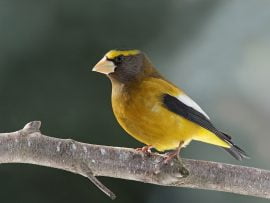Launched in 1998 by the Cornell Lab of Ornithology and National Audubon Society, the Great Backyard Bird Count was the first online citizen-science project to collect data on wild birds and to display results in near real-time.

Evening Grosbeak by GBBC participant Ted Schroeder, Oregon.
Now, more than 160,000 people of all ages and walks of life worldwide join the four-day count each February to create an annual snapshot of the distribution and abundance of birds.
List the birds you see in your backyard for at least 15 minutes on one or more days of the count, then enter your checklists at birdcount.org. Anyone with internet access can participate, no matter what their skill level—it’s a great family activity, too.
In the United States and Canada, 2019 bird lists are more likely to include sightings of winter finches and grosbeaks that are moving farther south than usual in what’s called an “irruption.” This type of movement is often sparked by poor cone, seed, and berry crops in parts of Canada, according to the GBBC website.
“This year is a very exciting one for backyard birders in the East, headlined by the largest Evening Grosbeak movement in at least two decades,” says the Cornell Lab of Ornithology’s Marshall Iliff, a leader of the eBird program. “From Atlantic Canada to North Carolina, these colorful feeder visitors have been making a splash.”
Although seed crops were better in western Canada, eBird maps still show significant number of Evening Grosbeaks are now being reported in the West all the way down to the border with Mexico. eBird collects bird observations globally every day of the year and is the online platform used by the GBBC.
This also an above-average year for Red Crossbills, Common Redpolls, Pine Grosbeaks, Common and Hoary Redpolls, and Red-breasted Nuthatches the website said.
”The Great Backyard Bird Count is a great way for all bird watchers to contribute to a global database of bird populations,” says Dr. Gary Langham, vice president and chief scientist for the National Audubon Society. “Participants in the Great Backyard Bird Count help scientists understand how things like climate change are impacting bird populations so we can better inform our conservation efforts.”
During the 2018 count, bird watchers from more than 100 countries submitted more than 180,000 bird checklists reporting a record 6,456 species–more than half the known bird species in the world.
You can count from any location, anywhere in the world, for as long as you wish.
If you’re new to the count, or have not participated since before the 2013 merger with eBird, you must create a free online account to enter your checklists. See http://gbbc.birdcount.org for full details.
—The Great Backyard Bird Count



